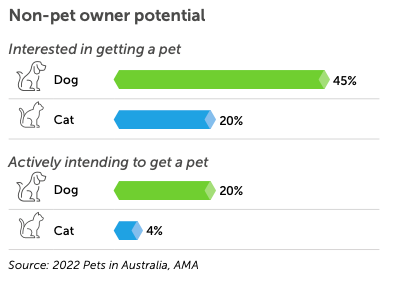Country report: Australia Zooming in on the boom in pet ownership

With nearly 7 out of 10 Aussie households owning pets, it is time to look at the trends in consumer behavior, product demand and expenditure.
Australian pet ownership rates remain high, with around 6.9 million households owning 1 or more pets. Australians now have an estimated 28.7 million pets in total, outnumbering the country’s human population of 25.8 million.
Pets in Australia, commissioned by Animal Medicines Australia (AMA), is the country’s most comprehensive pet population survey, with findings from nearly 2,500 households. The 2022 report confirms the observed growth in ownership that occurred during the pandemic.
More demand, higher prices
Australia’s pet populations grew strongly during the pandemic. In 2022, ownership rates were significantly higher than the consistent 61% ownership rate recorded in 2016 and 2019, and comparable with figures recorded in 2021 (69%).
Dogs remain the most popular pets, with a population of 6.4 million, and almost half of Australian households have at least one dog. Cats continue to be Australia’s second most popular pets, with 5.3 million.
Increases in demand have created challenging conditions for pet breeders and resulted in record- high purchase prices for households acquiring pets. The average price for a dog in 2022 was A$1,793 ($1,235 / €1,156), almost double the A$930 ($641 / €600) paid prior to 2020. Similarly, the average reported price for cats doubled to $804 ($554 / €519) in 2022.
Food accounts for half of spending
Expenditure rose to an estimated A$33.2 billion ($22.8B / €21.3B) last year. Food represents 51% of total spending, followed by veterinary services (14%), pet products and accessories (9%) and pet healthcare products (9%). The remainder of the total spend is attributable to services such as clipping and grooming (4%), pet insurance (3%), and training, behavior and therapy services (3%).
Vets remain the most trusted source of advice, with 84% of dog owners and 69% of cat owners taking their pets to the vet in the last 12 months – mostly for general check- ups and vaccinations. However, 68% of pet owners say they had considered not going to the vet when they needed to, driven partly by cost considerations.
Types of pet parents
The research identified 4 distinct pet ownership segments by further exploring the data for demographics, personal circumstances, attitudes and behaviors.
The largest cohort (30%) are driven by ‘affordability & convenience’. These owners are less likely to spend money on non-essential items. The second cohort (25%), many of whom are retirees and empty nesters, are looking for ‘simplicity & reliability’ to maintain a happy and well-cared-for pet companion.
‘Care & quality’ are key drivers for the third cohort (27%). These are generally families with middle to higher incomes who are willing and able to spend money across all pet products and services, including preventative care.
The fourth cohort, ‘appeal & reassurance’ (19%), are driven to care and share experiences with their pets, even if it means stretching the budget. These owners are often more likely to have more pets, and present the greatest opportunity for further education on keeping their pets healthy and happy.
Ownership experiences
For many pet owners, typical reasons for getting a pet include companionship, wanting to rescue an animal, relaxation and mental health, with 85% saying their pet had a positive impact on their physical and mental well-being (88% in 2019). The 3% who feel that pet ownership has impacted them negatively tend to refer to the costs of caring for pets, the level of cleaning required, the time and responsibility demands, and limits on their ability to travel and be spontaneous.
Pet owners are staunch advocates of the benefits of pet ownership. Around 59% are ‘Net Promoters’ and likely to recommend pet ownership and its benefits to friends or family members. In addition to the physical and mental benefits that pet owners regularly mention, this report also highlighted the social benefits of pet ownership, as pet owners noted the opportunities for social engagement with others through dog parks, casual encounters and club participation.
Non-owners and previous owners
Despite the growth in ownership, housing constraints and costs are key barriers holding back would-be owners and current owners hoping to access the benefits that come with pet ownership. Current non- owners – particularly renters and apartment dwellers – are especially likely to point to unsuitable homes or issues with landlords, legal bodies and residential laws as a reason for not bringing a pet into their lives.
Noting post-pandemic anecdotal reports of increases in pets being given up for adoption, the 2022 report sought to develop a baseline to track trends in pets being given up. While it is too early to identify any trends, or identify causal factors that may increase the risk of this happening, the report notes some aspects that may benefit from further investigation in the future.


